
| Trinicenter Home | PanTrinbago.com | RaceandHistory.com | HowComYouCom.com |
 |
|
News Links |
Message Board |
Trinicenter |
Historical Views |
Features |
Homepage |
|
Europe Homepage If you go to Rome, I highly recommend the "Oxford Archaeological Guide to Rome". Without it, you will miss much of what there is to see. |
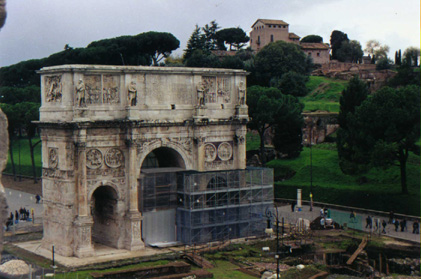
|
The Arch of Constantine North face of the arch from the third level of the Colosseum as it appeared in November of 1999. The hill in the background is the Palatine Hill. The lower western quarter and interior of the main arch were being renovated. The rest of the pictures on this page are from the same time, so these sections will not be represented. If anyone has pictures of these areas that I can post (taking into consideration copyright issues), please send them to me and I will post them with descriptions. The arch was dedicated on the tenth anniversary of Constantine's rule on July 25, 315 AD. |
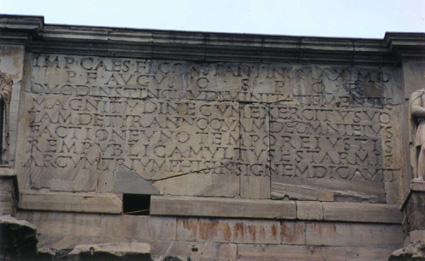
|
Inscription IMP CAES FL CONSTANTINO MAXIMO P F AUGUSTO S P Q R QUOD INSTINCTU DIVINITATUS MENTIS MAGNITUDINE CUM EXERCITU SUO TAM DE TYRANNO QUAM DE OMNI EIUS FACTIONE UNO TEMPORE IUSTIS REM PUBLICAM ULTUS EST ARMIS ARCUM TRIUMPHIS INSIGNEM DICAVIT To the emperor Flavius Constantine, the Great, pious and fortunate, the Senate and People of Rome, because by divine inspiration and his own great spirit with his army on both the tyrant and all his faction at once in rightful battle he avenged the State, dedicated this arch as a march of triumph. The tyrant in question was Maxentius, the battle, that at the Milvian Bridge which resulted in Maxentius' death and Constantine becoming emperor of a once again united empire. |
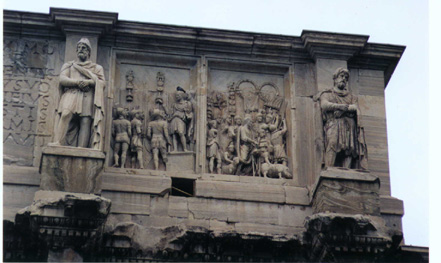
|
Attic Panel-Reliefs The arch was a gift by the senate of Rome to Constantine. It was meant to be a lesson on how a good emperor should act. Much of the arch is spolia, reused marble and artwork taken from other structures. The eight panels on the attic to the sides of the inscription were taken from a monument to Marcus Aurelius and the emperor's head was recut to resemble Constantine. These two panels depict the emperor addressing the troops after a battle and the emperor participating in a sacrifice of a ox, sheep and pig. This was wishfull thinking on the senate's part which wanted Constantine to follow the traditional pagan gods. |
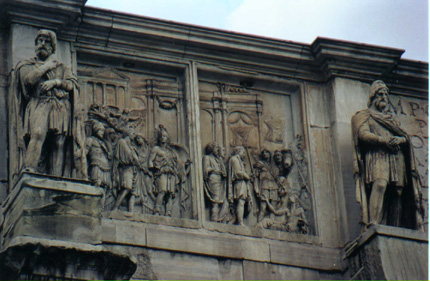
|
Attic Panel-Reliefs
The left panel shows the emperor flanked by Mars and Roma with victory in the background while in the forum. In the second panel, he leaves on campaign with the legions. |
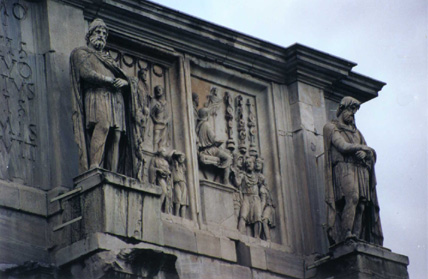
|
Attic Panel-Reliefs
In the first (obscured) panel, the emperor is shown giving gifts to the people of Rome. In the second, he is receiving the surrender of barbarians. |
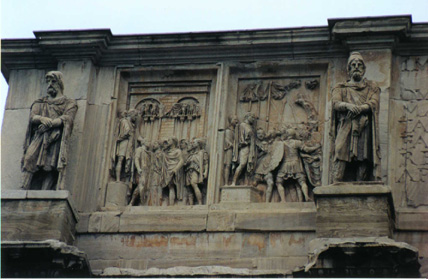
|
Attic Panel-Reliefs
In these two panels, the emperor addresses the troops. In the first, they listen two him intently. In the second, their spirits have been raised and they are ready for battle. |
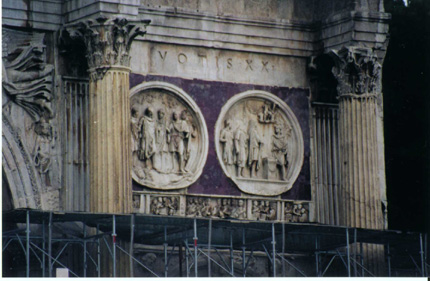
|
Hadrianic Roundels
Four sets of two roundels depict sacrifices to the gods Silvanus, Apollo, Diana and Hercules. They are believed to be from the time of Hadrian as Antinous (Hadrian's companion) and Antoninus Pius (Hadrian's designated successor) are depicted viewing the events. The emperor (most likely Hadrian) was again recut to depict Constantine. The friezes below each set of roundels are from the time of Constantine. It is in the style of the 4th century when people were depicted with shorter bodies and large eyes. These two roundels depict Licinius (Constantine's co-emperor at the time) on a lion hunt and Constantine sacrificing to Hercules. Constantine's father Constantius Chlorus claimed Hercules as an ancestor. |
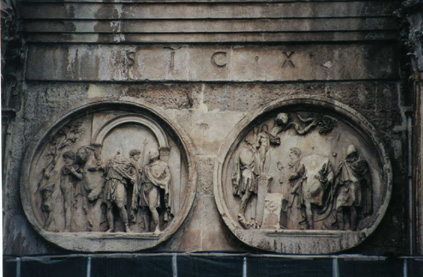
|
Hadrianic Roundels
The first of these roundels depicts a hunting party departing the city. The second is a sacrifice to Silvanus, the Roman god of the woods and wild. |
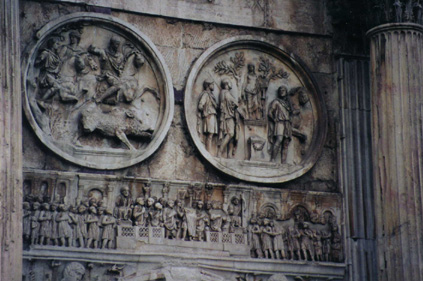
|
Hadrianic Roundels
The first of these roundels depicts the emperor, probably Licinius, hunting a wild boar. The emperor is on a horse about to strike the boar with a now missing spear. The second roundel depicts Constantine sacrificing to the god Apollo. Constantine was a follower of Apollo early in his career. |
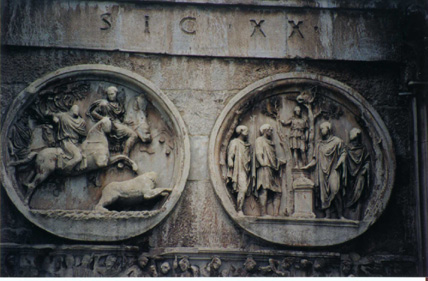
|
Hadrianic Roundels
The roundel on the left shows the emperor hunting a bear. The one on the right depicts a sacrifice to the goddess Diana. |
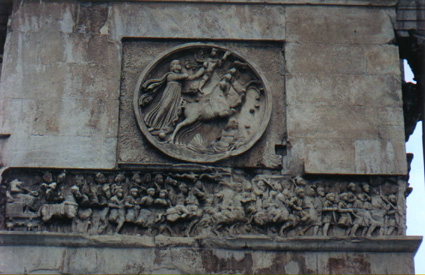
|
Roundel of Sol in driving a chariot
A matching roundel depicting Luna is on the opposite side of the arch. These symbolize the eternal nature of the empire. |
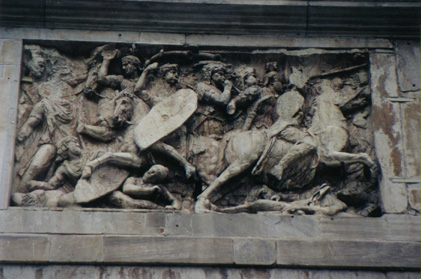
|
Trajanic Frieze
Known as the Trajanic Frieze, it could equally have been originally of Domitian. The frieze is a section from a large frieze that was divided into pieces and sections used on the short sides of the attic (such as this one) and in the great arch. The frieze portrayed the emperor (originally either Trajan or Domitian, recut to be Constantine) in battle against the Dacians. |
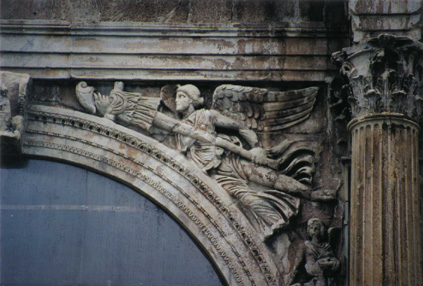
|
Victory
Winged victories with trophies in hand above the great arch on both sides. |
|
Raceandhistory.com | Howcomyoucom.com | Trinicenter.com | TriniView.com Another 100% non-profit Website serving poorly represented communities. Copyright & Disclaimer. - - Privacy Policy --Designed & maintained by S.E.L.F. © 2001 RaceandHistory.com |